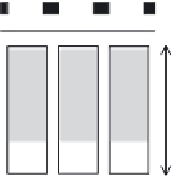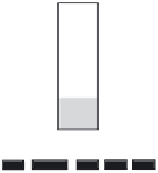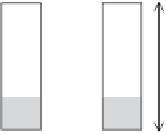Image Processing Reference
In-Depth Information
OCL
Color filter
Light shield film
Photodiode
3 µm depth
Metal wiring layers
1.0 µm pitch pixel
FIGURE 5.69
Cross-sectional view showing the aspect ratio of a substantial BSI of 1.0 μm pixel pitch.
Figure 5.69 shows a cross-sectional view of an actual pixel with 1.0 μm pixel pitch to
make it clear how the aspect ratio of the PD is high with a color filter for a single-sensor
color system. It is obvious that the PD is quite long vertically. As discussed in Section 2.2,
the depth of the PD must be around 3-3.5 μm to absorb enough red light independently
from the pixel pitch. Since the thickness of current dye or pigment absorption-type color
filters is around 1 μm, the length from the top of the OCL to the PD is never short from the
viewpoint of getting incident light to the PD effectively.
Since the shorter focal length of imaging optical elements is employed to achieve thin
cameras, the oblique component of the incident ray has been increasing, and rays that pass
through color filters that cannot control the direction of propagation enter the adjacent PD,
that is, an appreciable extent of cross talk occurs.
In the case of monochrome cameras, cross talk degrades the image sharpness or modu-
lation transfer function of spatial resolution, which can be corrected by signal process-
ing without severe side effects only by edge signal enhancement. On the other hand, the
situation caused by cross talk is quite different and more severe in SCCCs. Cross talk
causes mixing of not only spatial but also color information in SCCCs. This means inac-
curate color reproduction and unnatural color images, which human eyes are sensitive to.
Although a certain level of color mixture can be corrected by matrix operations in signal
processing, off-diagonal terms in the matrix correspond to mixing levels and are used in
calculations for corrections. Since each off-diagonal term already includes noise, noise is
reflected to calculated results in amplified or reduced form. Thus, color cross talk often
causes substantial noise amplification by the correction operation, and it should be sup-
pressed as much as possible. As described above, the situation in SCCCs is often quite dif-
ferent and much more severe than that in monochrome cameras.
To suppress undesirable cross talk for SCCCs, a light shield film is formed, as shown in
Figure 5.69. It is regrettable that BSIs have to give up their 100% aperture ratio for the above
reason, despite of so much effort and cost.













